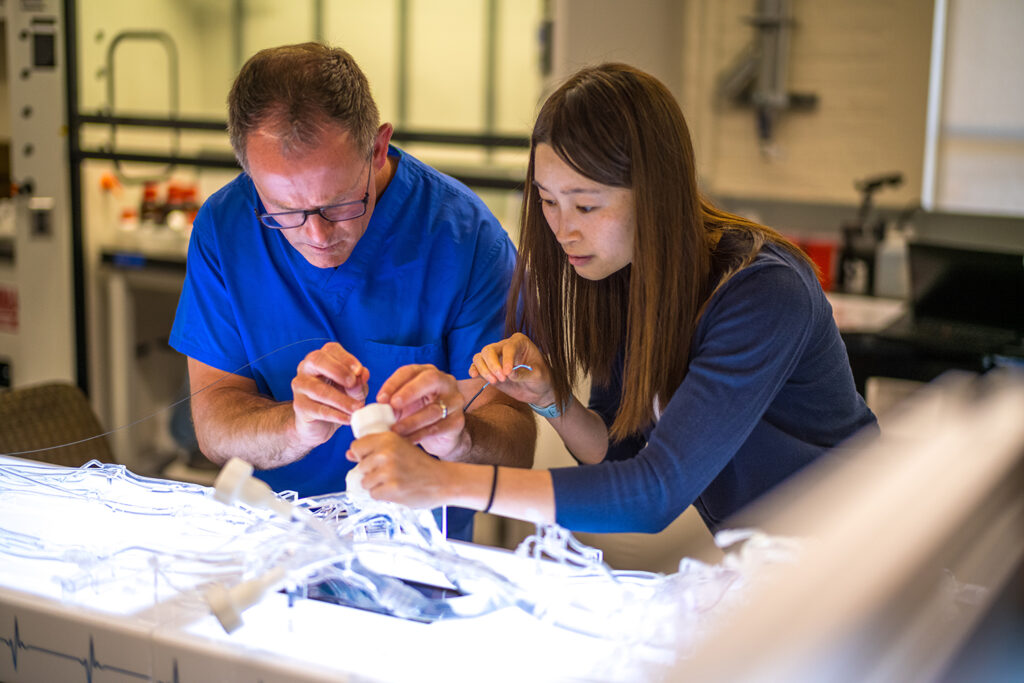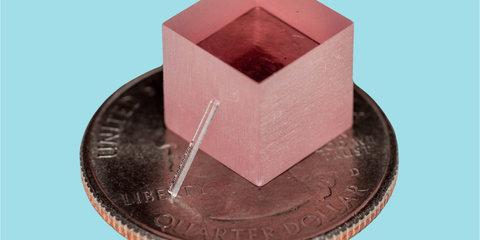Once in a single leap from tabletop to microscale, engineers from Stanford University fabricated the world’s first practical titanium-sapphire laser on a chip.
Researchers are now developing a chip-scaled Titanium-sapphire laser, dramatically smaller and less expensive than the jumbo-sized traditional models, thus making it more broadly applicable in quantum optics and neuroscience. With this new technology, it would empower labs to have hundreds of such powerful lasers on a single chip, requiring all of a simple green laser pointer.

As far as lasers go, Titanium-sapphire—Ti:sapphire—lasers are considered to have “unmatched” performance. They’re indispensable in many fields, including quantum optics, spectroscopy, and neuroscience. The problem is that all that comes at a steep price: Ti:sapphire lasers are huge, along the order of a cubic foot in volume. They cost hundreds of thousands of dollars apiece. And they need other high-powered lasers—in their own right, costing $30,000 each—to give them enough energy to actually function.
Breakthrough in Laser Technology
Due to this problem, Ti:sapphire lasers have never enjoyed the broad, real-world adoption they should – until now. In a spectacular step up in scale, efficiency, and price, researchers at Stanford University have developed a Ti:sapphire laser on a chip. The prototype is Four orders of magnitude smaller, 10 000 times, and three orders less expensive, 1 000 times, than any Ti – sapphire laser ever made.
Revolutionary Miniaturization and Cost Reduction
breakup “This is a complete departure from the old model,” said Jelena Vučković, the Jensen Huang Professor in Global Leadership, a professor of electrical engineering and senior author of the paper introducing the chip-scale Ti:sapphire laser published in the journal Nature. “Instead of one large and expensive laser, any lab might soon have hundreds of these valuable lasers on a single chip. And you can fuel it all with a green laser pointer.”
“When you leap from tabletop size and make something producible on a chip at such a low cost, it puts these powerful lasers in reach for a lot of different important applications,” said Joshua Yang, a doctoral candidate in Vučković’s lab and first author of the research with Vučković’s Nanoscale and Quantum Photonics Lab colleagues, research engineer Kasper Van Gasse and postdoctoral scholar Daniil M. Lukin.
Also Read: How is Google helpful in our daily life?
Technical Advantages and Possible Mass Production Potential Ti:sapphire lasers are technically so useful because they sport the largest “gain bandwidth” of any laser crystal, said Yang. In layman’s terms, the broader gain bandwidth means it could produce a wide range of colors compared with most other lasers. It’s ultrafast, Yang said. Pulses of light issue forth every quadrillionth of a second.
But Ti:sapphire lasers are also hard to come by. Even Vučković’s lab, which does cutting edge quantum optics experiments, only has a few of these prized lasers to share. The new Ti:sapphire laser fits on a chip that is measured in square millimeters. The researchers could be mass-producing them on wafers, possibly tens-of-thousands. Thousands of Ti:sapphire lasers could be squeezed onto a disk that fits into the palm of a human hand.
“A chip is light. It is portable. It is inexpensive and it is efficient. There are no moving parts. And it can be mass-produced,” Yang said. “What’s not to like? This democratizes Ti:sapphire lasers.”
Innovations in Manufacturing
To fashion the new laser, the researchers began with a bulk layer of Titanium-sapphire on a platform of silicon dioxide on, all riding atop true sapphire crystal. They then grind, etch, and polish the Ti:sapphire down to an incredibly thin layer, only a few hundred nanometers thick. Then they pattern into that thin layer a swirling vortex of tiny ridges. The ridges act very much like fiber-optic cables, guiding light around and around, building in intensity. Indeed, the pattern is called a waveguide.
“Mathematically speaking, intensity is power divided by area. So, if you keep the same power as the large-scale laser but decrease the area that it is focused on, the intensity becomes huge, ” Yang says. “The small scale for our laser actually helps us to make it more efficient.”
They fabricated that missing piece of the puzzle: a microscale heater that warms the light as it travels through these waveguides, letting the Vučković team alter the wavelength of the light that is emitted. That in turn lets them tune the color of the light anywhere between 700 and 1,000 nanometers – in the red to infrared.
Applications and Future Prospects
One thing that did excite Vučković, Yang, and colleagues the most is only the range of fields such a laser might impact. Quantum physics is supplied with a low-cost working solution that can scale down state-of-the-art quantum computers by many orders of magnitude. For neuroscience, the researchers envision immediate applications of this work in optogenetics—a field that enables scientists to control neurons with light guided inside the brain with relatively bulky optical fiber. They say small-scale lasers might be integrated into more compact probes, opening up new experimental avenues for this field. It may find new use in the Nobel Prize-winning chirped pulse amplification for laser surgery, or it can offer less expensive and more compact optical coherence tomography technologies that are used to assess the health of the retina in ophthalmology.
The team is working on perfecting a chip-scale Ti:sapphire laser and ways to mass-produce them, thousands at a time, on wafers. Yang will earn his doctorate this summer based on this research and is working to bring the technology to market.
“We could put thousands of lasers on a single 4-inch wafer,” Yang says, “That’s when the cost per laser starts to become almost zero. That’s pretty exciting”.
Reference: “Titanium:sapphire-on-insulator integrated lasers and amplifiers” by Joshua Yang, Kasper Van Gasse, Daniil M. Lukin, Melissa A. Guidry, Geun Ho Ahn, Alexander D. White and Jelena Vučković, 26 June 2024, Nature .
DOI: 10.1038/s41586-024-07457-2
Other contributing authors are postdoctoral scholar Melissa A. Guidry and doctoral candidates Geun Ho Ahn and Alexander D. White. Vučković is also an affiliate of Stanford Bio-X, Stanford PULSE Institute, and the Wu Tsai Neurosciences Institute.
This work was supported by the Institute of Engineering and Technology A.F. Harvey Prize, the Vannevar Bush Faculty Fellowship from the U.S. Department of Defense, the Defense Advanced Research Projects Agency, and the Air Force Office of Scientific Research. A portion of this work was performed at the Stanford Nano Shared Facilities and the Stanford Nanofabrication Facility and supported by the National Science Foundation.
Source: SciTechDaily
Read more news here

